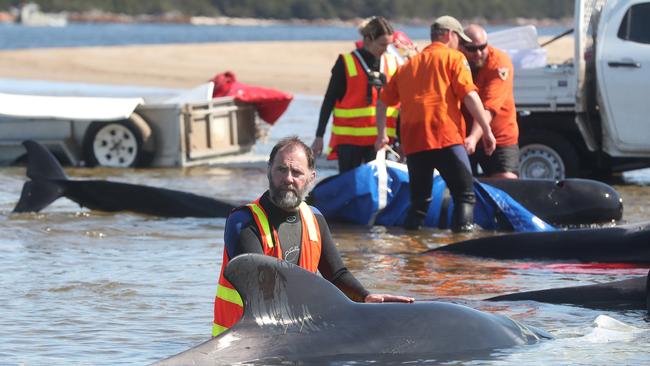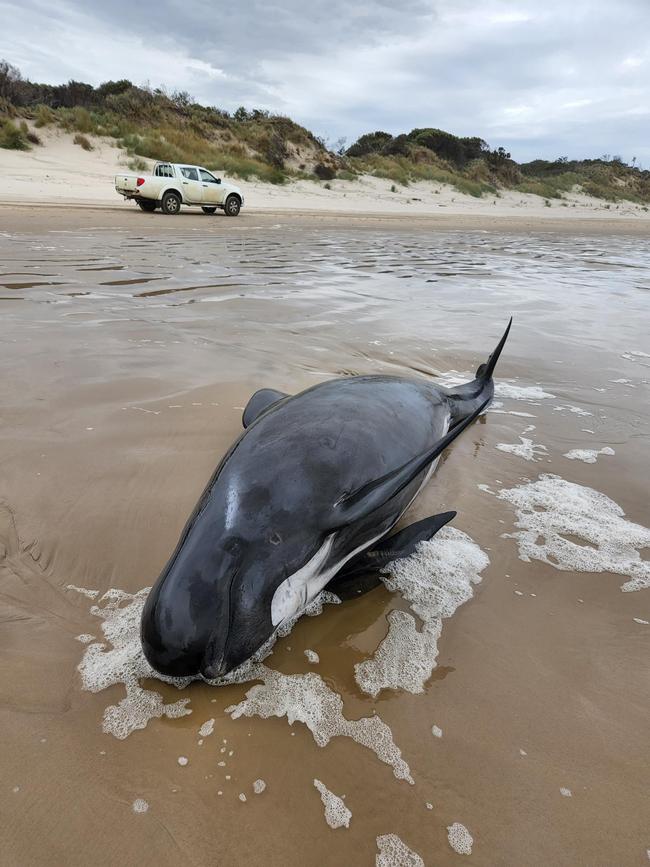Rescue effort saves 32 whales, but almost 200 dead
Rescuers have so far saved 32 of the 35 pilot whales that survived a stranding of about 230 of the animals on Tasmania’s West Coast, and will prioritise the remainder on Friday.

Rescuers have so far saved 32 of the 35 pilot whales that survived a stranding of about 230 of the animals on Tasmania’s West Coast, and will prioritise the remainder on Friday.
A “rescue and release” effort involving more than 50 people was undertaken on Thursday, with a mechanical lifter being used on Ocean Beach, near the town of Strahan.
Brendon Clark, from the Tasmanian Parks and Wildlife Service, said the trained rescuers were pleased with the day’s tough but rewarding work.
“It’s worked very effectively, our operations – of the 35 that were remaining alive this morning, we’ve managed to refloat, rescue and release 32,” Mr Clark said.
“That’s a terrific result.”
The whales, found beached on Wednesday, were triaged late on Wednesday and some assistance, in terms of shade and moisture, was provided.

Kris Carlyon, of Tasmania’s Marine Conservation Program, said the rescue involved shifting the animals – each weighing between a half and 2½ tonnes – on to specialised reinforced whale mats.
They were then lifted on to padded trailers with the help of a telehandler mechanical lifter, and taken to less exposed waters.
From there, they were slung between boats and taken out to deeper offshore waters, to minimise the risk of re-stranding.
“They’re confused, they’re disorientated, they’ve got some physiological things going on and really they are not at their best,” he said.
“So it’s always a chance these animals will try and re-strand.”
The area – Ocean Beach and Macquarie Heads, at the entrance to Macquarie Harbour – has been the scene of a number of whale and dolphin strandings, including Australia’s largest whale stranding of 470 pilot whales in late September 2020.


Dr Carlyon said it was thought the area’s topography – including a gentle sloping, shallow beach and breaking water – may make it a “natural whale trap”; confusing the whales’ eco-location navigation.
“They’re highly social animals so if one animal or a group of animals gets … into trouble, the whole group may follow them into shore and become stranded,” he said.
There has been discussion about the future use of deterrents, such as acoustic warning devices, to try to prevent further strandings in the area.
To see so many dead whales was “confronting”, as was the sight of distressed survivors communicating with each other.
“They are so far out of their natural environment,” he said. “It is always a sad sight.”
The dead whales are due to be towed out to deep ocean during the next few days.





To join the conversation, please log in. Don't have an account? Register
Join the conversation, you are commenting as Logout